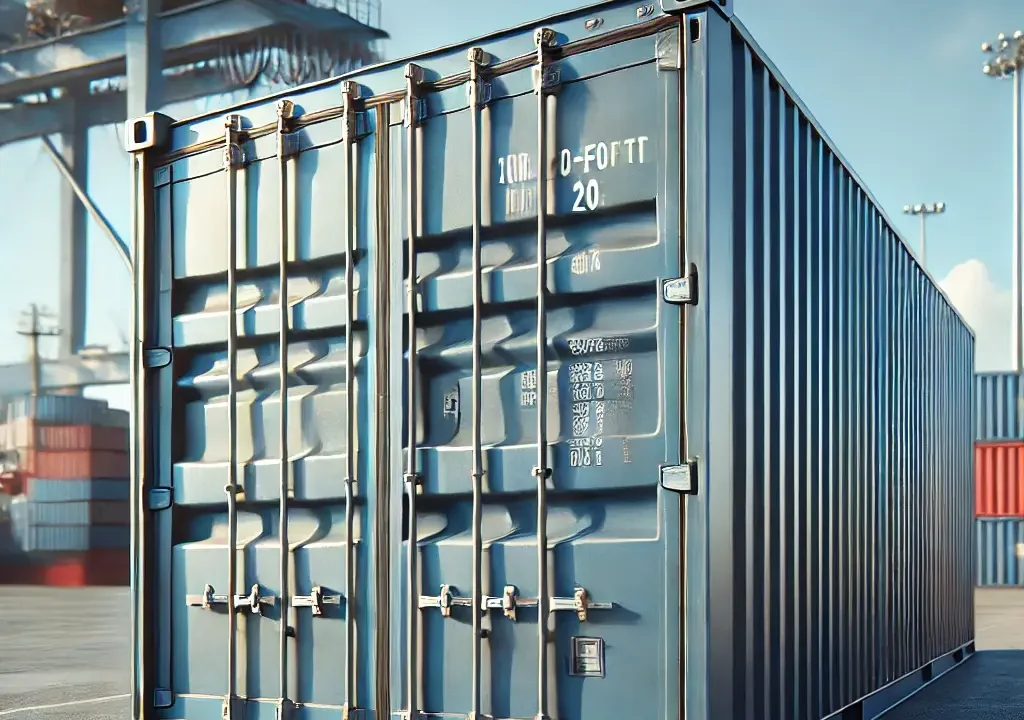Table of Contents
What buyer needs to know about TEU
When it comes to global shipping, understanding the intricacies of container sizes and their capacities is relevant for buyers. The 20-foot container (1 TEU (Twenty-foot Equivalent Unit)) is one of the most widely used containers in the industry, known for its versatility and efficiency. Whether you’re shipping electronics, textiles, or bulk goods like rice, knowing how to maximize the use of a 20-foot container can significantly impact your logistics and cost efficiency. In this blog post, we’ll dive into what buyer needs to know about TEU and about the 20-foot container, including their dimensions, capacity, and the types of goods they can accommodate.
What is a TEU unit?
A TEU, or Twenty-foot Equivalent Unit, is a standard measure used in shipping to describe the capacity of a container. A TEU container is a standard shipping container that is 20 feet long, 8 feet wide, and 8.5 feet high. These dimensions make it a versatile choice for transporting a wide range of goods across various shipping routes.
TEU (Twenty-foot Equivalent Unit) is a standard unit of measurement used in the shipping industry to describe the capacity of container ships and terminals. It is used as a reference point, where one TEU represents the volume of a standard 20-foot container.
When you are talking about the standard unit of measurement, use TEU. When you are referring to the actual container, it is more accurate to use 20-foot container.
So, in the context of explaining container specifications and shipping details to buyers, it is more appropriate to refer to a 20-foot container. If discussing capacity or industry standards, TEU is the correct term.
Dimensions and Capacity
Exterior Dimensions:
- Length: 20 feet (6.06 meters)
- Width: 8 feet (2.44 meters)
- Height: 8.5 feet (2.59 meters)
Interior Dimensions:
- Length: 19.35 feet (5.9 meters)
- Width: 7.7 feet (2.35 meters)
- Height: 7.9 feet (2.39 meters)
Capacity:
- Volume: Approximately 1,172 cubic feet (33.2 cubic meters)
- Maximum Payload: Around 55,126 pounds (25,000 kg)
Examples of What a 20-fot Container Can Hold
To give you a better idea, here are some examples of how much a 20-foot container can hold:
- Household Goods: Approximately the contents of a typical two to three-bedroom house, including furniture, appliances, and boxes.
- Pallets: Depending on the size, a 20-foot container can hold around 10 standard 48×40-inch pallets.
- Automobiles: It can fit one standard-sized car or several motorcycles.
- Consumer Goods: Thousands of boxes of consumer products like clothing, electronics, or packaged food.
Comparing FEU with TEU
When considering what buyer needs to know about TEU we also need to mention FEU. One FEU represents the volume of a standard 40-foot container, which is twice the size of a 20-foot container. The volume us approximately 2,390 cubic feet (67.7 cubic meters) for a standard container with a maximum Payload around 58,900 pounds (26,740 kg)

Determining the Market Price on Shipping Routes
The market price for shipping a container can vary widely based on several factors:
- Route Demand: Popular shipping routes (e.g., China to the USA) tend to have higher rates due to high demand.
- Seasonality: Rates can fluctuate with peak shipping seasons, such as the period before major holidays.
- Fuel Prices: Fluctuations in fuel prices can directly impact shipping costs.
- Port Fees: Charges for handling and processing at ports can vary significantly.
- Global Events: Economic changes, political instability, or natural disasters can affect shipping costs.
To stay updated on market prices, industry professionals often use tools like the World Container Index or Freightos Baltic Index, which provide real-time data on container shipping rates across various routes.
How is the Price for a Shipment Set?
The price for shipping a 20-foot container is set based on several components:
- Base Freight Rate: This is the core cost of transporting the container from the origin port to the destination port.
- Surcharges and Fees:
- Bunker Adjustment Factor (BAF): Adjusts for fuel price changes.
- Currency Adjustment Factor (CAF): Accounts for currency fluctuations.
- Peak Season Surcharge (PSS): Applied during high-demand periods.
- Port and Terminal Handling Charges: Costs for loading and unloading the container at ports.
- Documentation Fees: Charges for processing shipping documents.
- Inland Transportation: Costs for transporting the container from the port to its final destination, if applicable.
- Insurance: Optional but recommended coverage for the value of the goods being shipped.
Additional Considerations
When planning a shipment, it’s essential to:
- Compare Quotes: Get quotes from multiple shipping lines and freight forwarders to find the best rate.
- Plan Ahead: Book shipments well in advance, especially during peak seasons, to secure better rates and ensure space availability.
- Understand Incoterms: Familiarize yourself with international commercial terms (Incoterms) to clarify responsibilities and costs between buyers and sellers.
These are the basic buyer needs to know about TEU and by understanding these elements, buyers can make informed decisions, optimize costs, and ensure their goods are shipped efficiently and safely.
Key Specifications to Include in an RFQ for a 1 TEU Container Shipment
When sending a Request for Quotation (RFQ) to a freight forwarder for a shipment using a 1 TEU container, it’s essential to provide detailed and precise information. This ensures you receive a high-quality and accurate offer. Here are the critical specifications and details to include:
1. Shipment Details
- Type of Goods: Clearly describe the type of goods being shipped (e.g., electronics, textiles, machinery).
- Volume and Weight: Provide the total volume and weight of the shipment.
- Packaging: Detail how the goods are packaged (e.g., pallets, boxes, loose cargo).
2. Container Specifications
- Container Type: Specify the type of container needed (e.g., standard dry container, refrigerated container, high cube).
- Special Requirements: Mention any special requirements (e.g., temperature control, hazardous materials, oversized cargo).
3. Origin and Destination
- Pickup Location: Exact address of the origin (factory, warehouse, etc.).
- Delivery Location: Exact address of the final destination.
- Port of Loading: Name of the port where the container will be loaded.
- Port of Discharge: Name of the port where the container will be unloaded.
4. Shipping Schedule
- Preferred Shipping Date: Indicate the preferred date for shipment.
- Delivery Deadline: Specify any critical deadlines for delivery.
5. Incoterms
- Incoterms: State the Incoterms (e.g., FOB, CIF, DDP) to clarify responsibilities and costs between the buyer and seller.
6. Insurance Requirements
- Insurance Coverage: Specify if insurance is required and the level of coverage needed.
7. Documentation
- Required Documentation: List any specific documentation needed (e.g., commercial invoice, packing list, certificates of origin).
- Customs Clearance: Specify if customs clearance services are needed at the origin and/or destination.
8. Additional Services
- Additional Services: Mention if additional services are required, such as:
- Warehousing: Temporary storage at origin or destination.
- Inland Transportation: Transport to/from the port.
- Cargo Inspection: Pre-shipment or post-shipment inspections.
9. Compliance and Regulations
- Regulatory Compliance: Ensure that the forwarder understands any specific regulatory requirements or certifications needed for the goods.
- Destination Country Regulations: Provide information on any special regulations or requirements in the destination country.
10. Communication and Tracking
- Communication Preferences: Specify preferred methods of communication and key contact persons.
- Tracking Requirements: Indicate if real-time tracking and updates are required during transit.
Sample RFQ for TEU Container Shipment (illustration purposes only).
RFQ for 1 TEU Container Shipment
1. Shipment Details:
- Type of Goods: Rice (e.g., Basmati rice, packaged in 50 kg bags)
- Volume and Weight: Total volume 28 cubic meters, total weight 20,000 kg
- Packaging: Goods packed in 400 bags, each weighing 50 kg
2. Container Specifications:
- Container Type: Standard dry 20-foot container
- Special Requirements: Ensure container is clean and dry to prevent contamination
3. Origin and Destination:
- Pickup Location: 123 Rice Mill Road, Mumbai, India
- Delivery Location: 456 Distribution Center, Rotterdam, Netherlands
- Port of Loading: Port of Mumbai
- Port of Discharge: Port of Rotterdam
4. Shipping Schedule:
- Preferred Shipping Date: August 15, 2024
- Delivery Deadline: September 10, 2024
5. Incoterms:
- Incoterms: FOB Mumbai
6. Insurance Requirements:
- Insurance Coverage: Full value coverage for rice
7. Documentation:
- Required Documentation: Commercial invoice, packing list, phytosanitary certificate, certificates of origin
- Customs Clearance: Required at both origin and destination
8. Additional Services:
- Warehousing: Temporary storage at destination for up to 7 days
- Inland Transportation: Trucking from Port of Rotterdam to final delivery location
9. Compliance and Regulations:
- Regulatory Compliance: Ensure compliance with EU import regulations for food products
- Destination Country Regulations: Adherence to EU health and safety standards for rice
10. Communication and Tracking:
- Communication Preferences: Email updates to [your email] and phone contact at [your phone number]
- Tracking Requirements: Real-time tracking updates during transit
Please provide a detailed quote including all costs and any additional information required. We look forward to your prompt response.
Best regards,
[Your Name]
[Your Company]
[Your Contact Information]
By including these detailed specifications in your RFQ, you ensure that freight forwarders can provide precise and comprehensive offers, enabling you to choose the best solution for your shipping needs. Always adapt your RFQ to your specific conditions.
Visualization of container in operation
Summary: What a buyer needs to know about TEU
The TEU, or Twenty-foot Equivalent Unit, is a standard measurement used in the shipping industry to describe the capacity of container ships and terminals. One TEU represents the volume of a standard 20-foot container, making it a key reference point for logistics professionals.
When requesting a quote (RFQ) for shipping using a 20-foot container, it is crucial to provide detailed information to ensure accurate and comprehensive offers from freight forwarders.
By understanding the dimensions, capacity, and best practices for requesting quotes, buyers can effectively utilize 20-foot containers for their shipping needs, ensuring efficient and cost-effective logistics operations.
Learn mire about TEU and sourcing container shipments by using FAQ at Maersk.
If you want to learn more about Learn How to Source and the online courses provided specifically for buyers, please visit our full display of courses at Learn How to Source. One can see Learn How to Source as a community where experienced procurement experts have converted their procurement expertise to online courses – made available to you anytime and anywhere via our online store. All you need is a web browser and internet connection.
Note: Illustration to the blogpost “What a buyer needs to know about TEU” was created by Chat GPT on July 1, 2024.
Information about our Online Procurement courses in Swedish.
